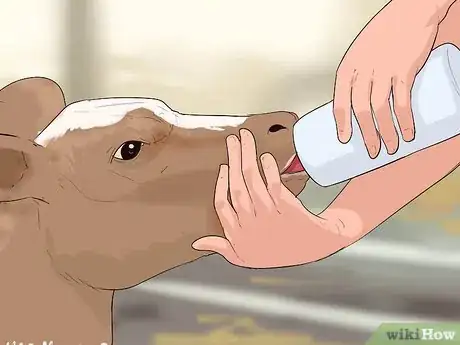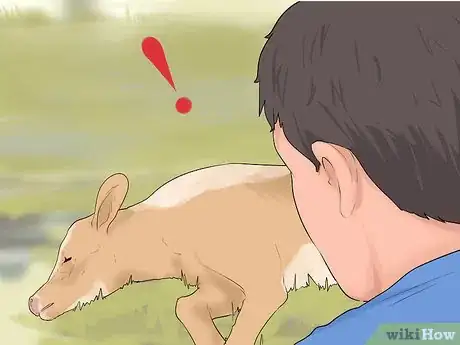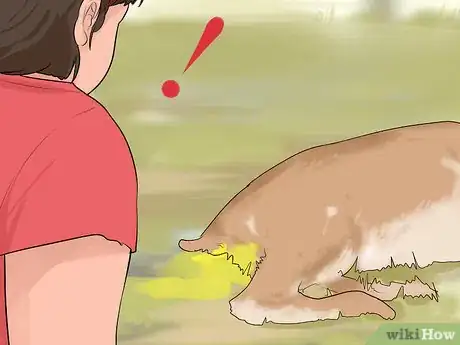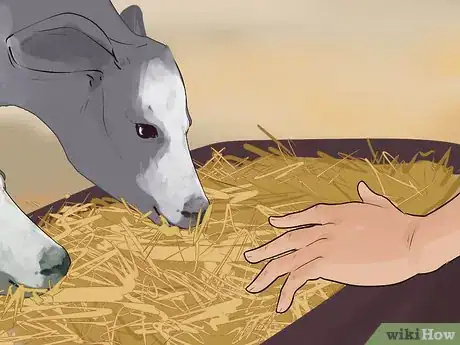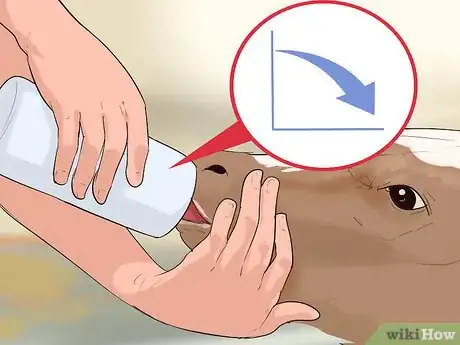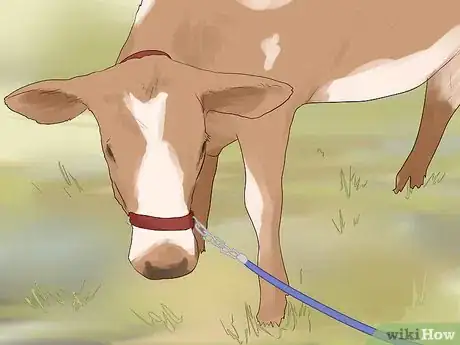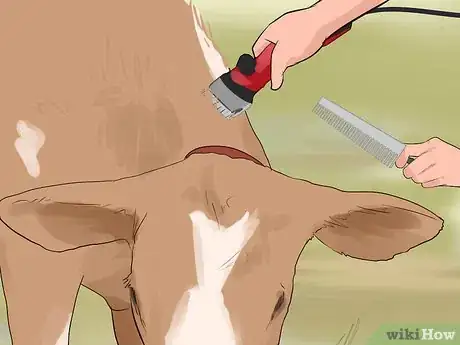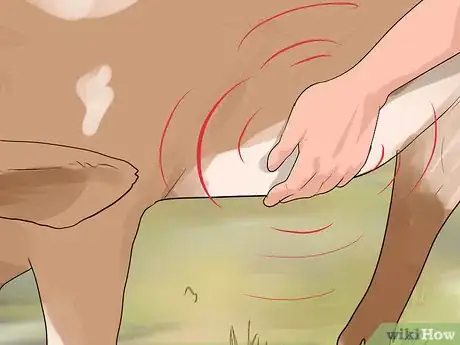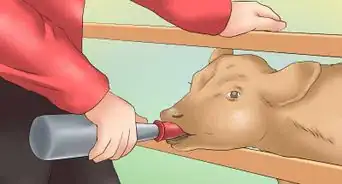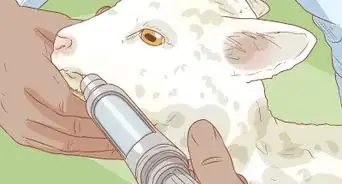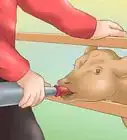This article was co-authored by wikiHow Staff. Our trained team of editors and researchers validate articles for accuracy and comprehensiveness. wikiHow's Content Management Team carefully monitors the work from our editorial staff to ensure that each article is backed by trusted research and meets our high quality standards.
There are 7 references cited in this article, which can be found at the bottom of the page.
wikiHow marks an article as reader-approved once it receives enough positive feedback. In this case, 100% of readers who voted found the article helpful, earning it our reader-approved status.
This article has been viewed 210,521 times.
Learn more...
Bucket calves, so named because of how they’re fed from birth until weaning, are easy to raise. In fact, for children interested in caring for livestock; raising bucket calves may be the perfect project.[1] If you or your little ones are interested in raising bucket calves, you’ll need to know how to best care for them in many ways to ensure their well-being.
Steps
Feeding the Calves
-
1Get calf bottles and nipples. Purchase one set of bottles and nipples per calf. Each calf should have at least one assigned set. Otherwise, you will need to go to the trouble of sterilizing the equipment between uses.
- The nipple of a bottle resembles the mother's teat, which should trigger the calf's natural instinct to suckle.[2]
- Bottles and nipples can be purchased online or at major retail stores such as Tractor Supply Co.
-
2Give them colostrum to start. Similar to human babies and breastmilk, the newborn calf should be fed fed colostrum, or milk produced by the mother, for the first few days. This is because the colostrum contains antibodies that the calf needs to develop a strong immune system.[3]
- If you purchased the calf, chances are it didn’t receive that much needed colostrum.
- Replacement colostrum can be obtained in frozen form, from a dairy farm, or from one of your other cows who has just given birth.
- If you are thawing frozen colostrum, be very careful not to overheat it or you will destroy its antibodies.
- Use warm water, anything less than 120°F or 50°C and allow it to thaw. A microwave oven can also be used to thaw the milk without causing damage.[4]
- Replacement colostrum should be given to the calf for about four days.
Advertisement -
3Switch to milk. Calves need milk for the first month or so of their lives. There are several different milk options.
- Cow’s milk. If one of your cows gave birth recently, you can use their milk. Most cows produce enough milk to adequately care for their young.[5]
- Replacement milk. If you’re using replacement milk, always follow the directions on the package. The temperature should be high enough to allow the fats in the milk replacer to melt into liquid form. This will help the calf to better absorb it, while keeping the mix consistent. Milk replacer formula should not be too hot either.[6]
- Goat’s milk. If mother’s milk isn’t available or if milk replacement is too costly, consider goat’s milk. It is easily digestible and may result in fewer cases of scours (a clinical sign associated with several diseases characterized by diarrhea)
-
4Create a feeding schedule. Young calves need routine, so feed them twice a day at the same times each day. Typically, the best feeding times for young calves are early morning and evening.[7]
- Start slow with a half of a bottle at each feeding and gradually increase it to two full feedings.[8]
- During the winter or other cold spells, you may need to increase the feedings to three times a day. The third feeding can take place mid-day.
Ensuring Their Well-Being
-
1Look for signs of stress. This is particularly important if you have recently purchased and transported the calf.
- Once they are at your home, keep the routine consistent. Changes in routine may cause stress in calves, which leads to a higher likelihood of illness.
- If the stress is severe, your calf could develop serious medical conditions such as scours.
-
2Watch for scouring. Scours, unfortunately, can be deadly for a young calf. Immediately treat scours using fluid therapy, which entails giving the calf the water and electrolytes that it has lost as a result of the illness.[9]
- Signs of scours include watery stool, appearing too weak to drink or stand and swaggering when they walk.
- To treat a calf with scours, try the following:
- Administer electrolytes through a feeder. 2 - 6 quarts of electrolytes may need to be administered on a daily basis, but should be given based on the size of the calf and the severity of the illness.[10]
- Give them liquids through an IV. Fluids are administered using a catheter, which is placed directly into the jugular vein.[11] You will need to contact a veterinarian to administer this form of treatment.
- Warm them up. Take preventative measures against the cold, including warm bedding and proper shelter from the elements so that the calf does not experience excessive cold stress in addition to it's existing condition.[12]
-
3Keep your calves warm. A comfortable temperature is anywhere from 50°F to 85°F. This environment helps to promote performance, while offering the least amount of stress for the calf.
- If the barn is drafty or if it’s exceptionally cold, you may need to bring in a heat source for your calves. Similarly, you will need to keep their space cool, should temperatures rise.
- Consider other environmental factors such as humidity, wind-chill and moisture, which can affect the temperature in the calf's space.
Weaning Your Animal
-
1Offer hay. When a calf stops relying solely on liquids such as milk and begins to eat dry, solid food, this is referred to as weaning.[13]
- Make sure hay is available to the calf a few days after they are born. They should only be offered a small amount to begin with.
- You will need to monitor how much hay they are consuming. Once they are eating at least 1 1/2 pounds of calf starter or hay per day, you can begin weaning them.[14]
-
2Slowly reduce milk. Begin reducing the amount of milk the calf is drinking and replace it with water.
- This can be done over the course of one to two weeks.
- There are commercially available "calf starter" food products that you can purchase to help with the transition from milk to solids.
-
3
Introducing Them to Humans
-
1Teach them to lead. One of the first things you may choose to do with a bucket calf is train it to lead (using a halter to lead it with a rope from place to place).
- To prepare your calf for the process, try gently petting her while she’s drinking. You can also put a halter on a new calf and lead her to the bottle of milk. This will incentivise her to move while getting her used to the halter.
- Try to lead your calf by not tugging hard on the halter. Instead, have someone apply pressure from behind, to encourage the calf to move.
- Consider using a halter with padding, as it will be comfortable for the calf.
- Always be patient and kind when using a halter and teaching the calf to lead.
-
2Groom your calf. One way to teach the calf to enjoy being handled by people, is to groom them.[17]
- Be cautious when grooming your calf. You’ll want to move slowly so as not to frighten it.
- Make sure you are using a halter and only giving the calf a few inches to move.
- Use a scotch comb along with a rice root brush to remove any mud and dirt that has accumulated on your calf's body.
- Next, you can use a hose and soap that is made for livestock to wash your calf. Make sure the hose pressure is on low to medium.
- Once you’ve washed her, use another scotch comb to ensure the hair is nice and smooth.
-
3Show them some love. Calves need some love too. Stroke her sides, belly, udder, and hind legs to get your calf used to human touch. This will help teach her to ignore or even enjoy being handled.[18]
Community Q&A
-
QuestionDo they live well with this plan?
 Community AnswerYes. They often do. They also live well with some discipline, like being halter trained.
Community AnswerYes. They often do. They also live well with some discipline, like being halter trained. -
QuestionWhy are they called bucket calves?
 Community AnswerThey're called bucket calves because large dairy operations typically feed them milk from a bucket from the start rather than using bottles. Bottles require too much labor. Many unwanted calves (especially males) originate from dairy operations.
Community AnswerThey're called bucket calves because large dairy operations typically feed them milk from a bucket from the start rather than using bottles. Bottles require too much labor. Many unwanted calves (especially males) originate from dairy operations. -
QuestionHow do I get calves to drink from a bucket?
 Community AnswerGet something they like to eat and hold it close to the bucket. When it gets close, hold the treat under the water. Then when it put its head in the water, pull the treat away and it will think the water is a treat.
Community AnswerGet something they like to eat and hold it close to the bucket. When it gets close, hold the treat under the water. Then when it put its head in the water, pull the treat away and it will think the water is a treat.
Warnings
- Sterilize equipment and clean it thoroughly after every single use. Bacteria can grow in the residue of colostrum and milk in the bottles and make the calf very sick.⧼thumbs_response⧽
Things You'll Need
- Colostrum
- Bottle and nipples
- Cow's milk or milk replacement or goat's milk
- Calf starter feed
- Hay, grain
- Warm shelter
- Grooming equipment
- Halter and leash
- Scheduled time for feedings (keep it regular)
References
- ↑ http://www.livingthecountrylife.com/animals/livestock/tips-for-raising-bucket-calves/
- ↑ http://www.tractorsupply.com/know-how_pets-livestock_cattle_feeding-calves
- ↑ http://www.livingthecountrylife.com/animals/livestock/tips-for-raising-bucket-calves/
- ↑ http://www.calfnotes.com/pdffiles/CN013.pdf
- ↑ http://animals.mom.me/much-feed-cow-nursing-calf-11370.html
- ↑ http://www.tractorsupply.com/know-how_pets-livestock_cattle_feeding-calves
- ↑ http://www.tractorsupply.com/know-how_pets-livestock_cattle_feeding-calves
- ↑ http://www.livingthecountrylife.com/animals/livestock/tips-for-raising-bucket-calves/
- ↑ http://msue.anr.msu.edu/news/calf_scours_signs_treatment_and_prevention_part_2
- ↑ http://msue.anr.msu.edu/news/calf_scours_signs_treatment_and_prevention_part_2
- ↑ http://msue.anr.msu.edu/news/calf_scours_signs_treatment_and_prevention_part_2
- ↑ http://msue.anr.msu.edu/news/calf_scours_signs_treatment_and_prevention_part_2
- ↑ http://animals.mom.me/wean-bottle-fed-calf-2619.html
- ↑ http://animals.mom.me/wean-bottle-fed-calf-2619.html
- ↑ http://www.livingthecountrylife.com/animals/livestock/tips-for-raising-bucket-calves/
- ↑ http://animals.mom.me/wean-bottle-fed-calf-2619.html
- ↑ http://www.backwoodshome.com/bottle-raise-a-calf/
- ↑ http://www.backwoodshome.com/bottle-raise-a-calf/
About This Article
If you want to raise bucket calves, start by bottle-feeding the calves colostrum for the first 4 days of its life. You can get replacement colostrum in frozen form, from a dairy farm, or from another cow that has just given birth. Feed the calves twice daily, at the same times each day. After a few days, switch to regular milk until the calf is about 1 month old, then slowly replace the milk with water as you wean the calf. Keep reading for tips on how to wean the calf!


